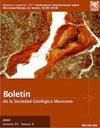拉丁美洲和加勒比地区的矿藏。前言
IF 0.5
4区 地球科学
Q4 GEOLOGY
引用次数: 2
摘要
根据美国地质调查局的《2020年矿产商品摘要》,包括拉丁美洲和加勒比地区在内的地区是采矿和矿产勘探的首选目的地(https://www.usgs.gov/centers/nmic/)。该地区蕴藏着铜、金、银、镍、钴、铁、铌、铝、锌、铅、锡、锂、铬和其他金属的重要资源。例如,智利是世界上最大的铜生产国和第二大锂生产国。巴西是世界领先的铌生产国、第二大铁矿石生产国和第三大钽生产国。古巴拥有世界上最大的镍和钴储量,与红土型镍钴矿床有关。墨西哥传统上是最大的白银生产国,拥有该商品中最大的两个矿山,与秘鲁、智利、玻利维亚和阿根廷一起,占全球白银生产总量的一半以上。该地区还拥有几个世界级金矿(例如,多米尼加共和国的普韦布洛-维埃霍、巴西的帕拉科图、阿根廷的维拉德罗和秘鲁的亚纳科查)。此外,玻利维亚和巴西是世界领先的锡生产国之一。该地区拥有多种矿床类型,其中最突出的是斑岩铜和浅成热液贵金属、铝土矿和红土镍、带状铁形成的红土铁矿、氧化铁铜金(IOCG)、硫化物矽卡岩、火山成因块状硫化物(VMS)、密西西比河谷型(MVT),与碱性-碳酸盐岩杂岩、锡-锑多金属矿脉和蛇绿铬铁矿有关的原生和风化相关含铌矿物。这期关于墨西哥地质学会拉丁美洲和加勒比矿床的特刊包含19篇论文。捐款描述了墨西哥、巴拿马、古巴、多米尼加共和国、哥伦比亚、委内瑞拉、厄瓜多尔、智利和阿根廷的矿床。本卷论文涵盖四个矿物系统(镁铁质-超镁铁质正岩浆矿物系统、斑岩-矽卡岩-浅成热液矿物系统、氧化铁-铜-金矿物系统和表层矿矿物系统)。这期特刊还包括关于工业矿物、矿石发现技术(使用GIS进行矿产勘探预测建模)、区域成矿学和采矿史的论文。本文章由计算机程序翻译,如有差异,请以英文原文为准。
Mineral deposits of Latin America and the Caribbean. Preface
The region that encompasses Latin America and the Caribbean is a preferential destination for mining and mineral exploration, according to the Mineral Commodity Summaries 2020 of the US Geological Survey (https://www.usgs.gov/centers/nmic/). The region contains important resources of copper, gold, silver, nickel, cobalt, iron, niobium, aluminum, zinc, lead, tin, lithium, chromium, and other metals. For example, Chile is the world’s largest copper producer and the second largest lithium producer. Brazil is the world’s leading niobium producer, the second largest producer of iron ore, and the third-ranked producer of tantalum. Cuba contains some of the largest reserves of nickel and cobalt in the world, associated with lateritic Ni-Co deposits. Mexico is traditionally the largest silver producer and contains the two largest mines in this commodity and, along with Peru, Chile, Bolivia and Argentina, accounts for more than half of the total amount of global silver production. The region also hosts several world-class gold mines (e.g., Pueblo Viejo in the Dominican Republic, Paracotu in Brazil, Veladero in Argentina, and Yanacocha in Peru). Also, Bolivia and Brazil are among the world’s leading producers of tin. The region hosts a variety of deposit types, among which the most outstanding are porphyry copper and epithermal precious metal, bauxite and lateritic nickel, lateritic iron ore from banded iron-formation, iron-oxide-copper-gold (IOCG), sulfide skarn, volcanogenic massive sulfide (VMS), Mississippi Valley type (MVT), primary and weathering-related Nb-bearing minerals associated with alkaline–carbonatite complexes, tin–antimony polymetallic veins, and ophiolitic chromite. This special issue on Mineral Deposits of Latin America and the Caribbean in the Boletín de la Sociedad Geológica Mexicana contains nineteen papers. Contributions describe mineral deposits from Mexico, Panama, Cuba, Dominican Republic, Colombia, Venezuela, Ecuador, Chile, and Argentina. This volume of papers covers four mineral systems (mafic-ultramafic orthomagmatic mineral systems, porphyry-skarn-epithermal mineral systems, iron oxide copper-gold mineral systems, and surficial mineral systems). This special issue also includes papers on industrial minerals, techniques for ore discovery (predictive modelling of mineral exploration using GIS), regional metallogeny and mining history.
求助全文
通过发布文献求助,成功后即可免费获取论文全文。
去求助
来源期刊
CiteScore
1.40
自引率
12.50%
发文量
34
审稿时长
50 weeks
期刊介绍:
The Boletín de la Sociedad Geológica Mexicana is a completely free-access electronic journal published semi-annually that publishes papers and technical notes with its main objective to contribute to an understanding of the geology of Mexico, of its neighbor areas, and of geologically similar areas anywhere on Earth’s crust. Geology has no boundaries so we may publish papers on any area of knowledge that is interesting to our readers.
We also favor the publication of papers on relatively unfamiliar subjects and objectives in mainstream journals, e.g., papers devoted to new methodologies or their improvement, and areas of knowledge that in the past had relatively little attention paid them in Mexican journals, such as urban geology, water management, environmental geology, and ore deposits, among others. Mexico is a land of volcanos, earthquakes, vast resources in minerals and petroleum, and a shortage of water. Consequently, these topics should certainly be of major interest to our readers, our Society, and society in general. Furthermore, the Boletín has been published since 1904; that makes it one of the oldest scientific journals currently active in Mexico and, most notably, its entire contents, from the first issue on, are available online.

 求助内容:
求助内容: 应助结果提醒方式:
应助结果提醒方式:


